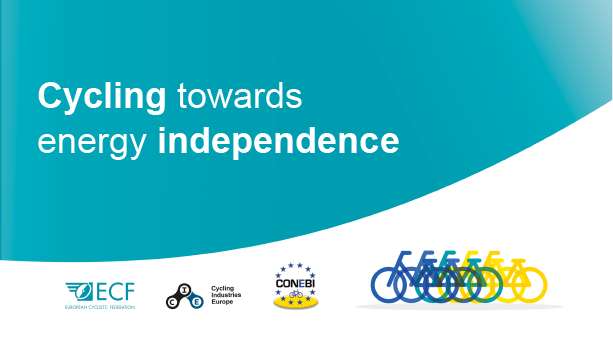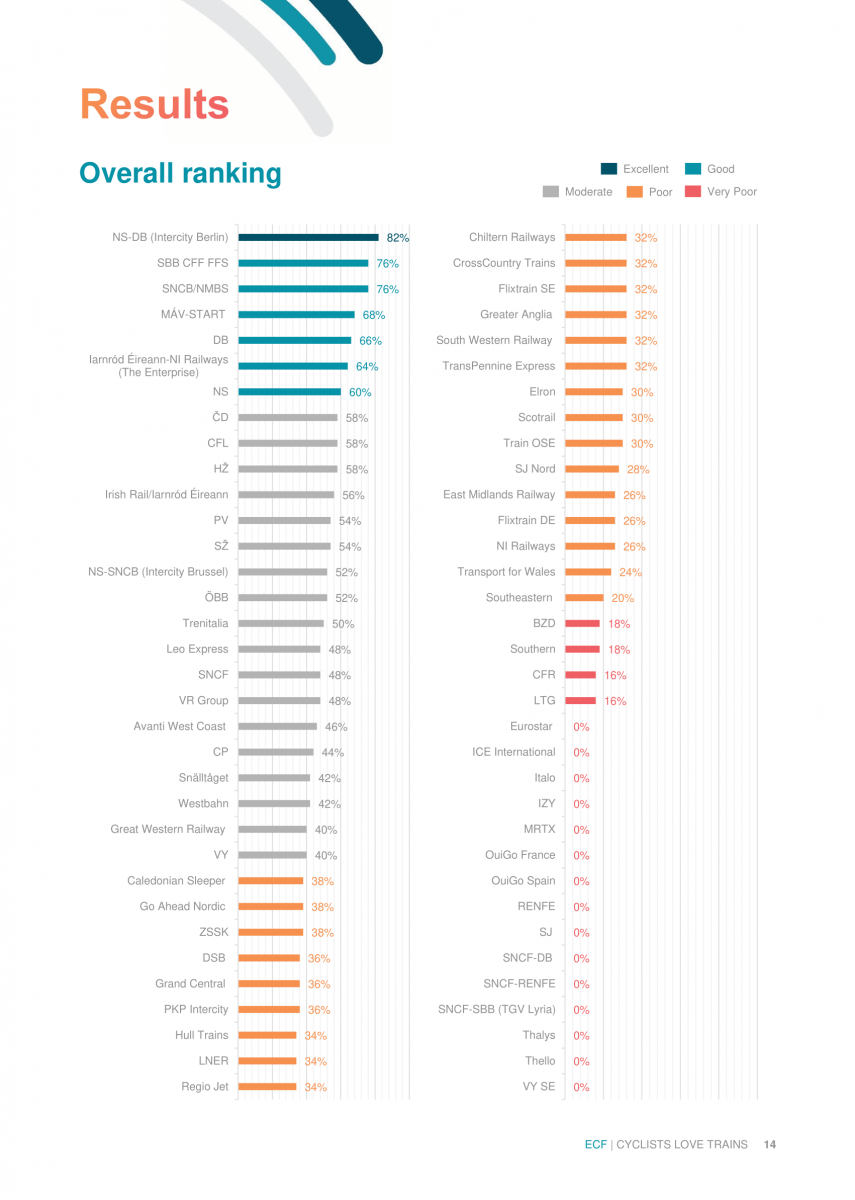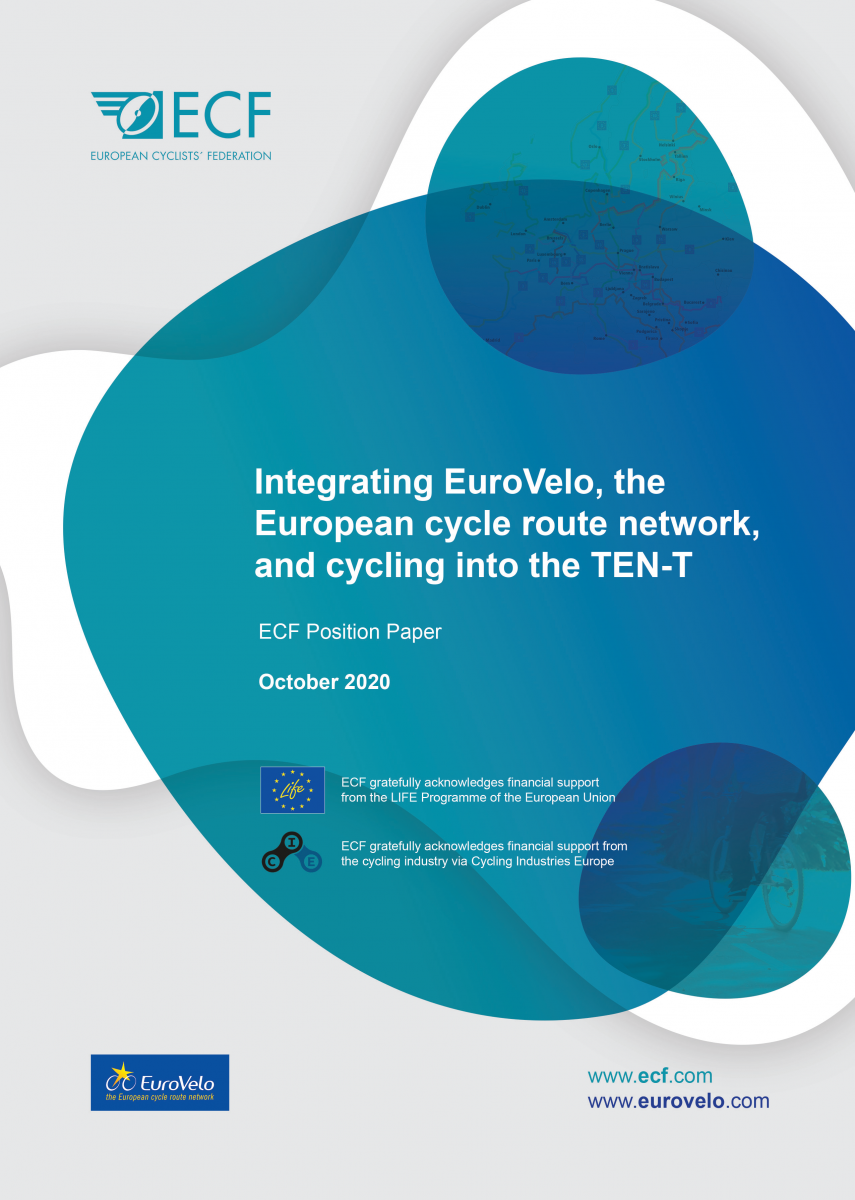ECF fully supports the European Commission’s proposal to give cycling a much stronger role in the recast of the Energy Performance of Buildings Directive, published on 15 December 2021. Cycling is the most energy efficient mode of transport and providing easily accessible and secure parking infrastructure is just as critical for its regular use as charging infrastructure is for electric cars.
Having said this, there is still room for further improvement to the European Commission’s proposal. This document provides suggested amendments to the proposal that would help to ensure more bicycle-friendly buildings with EU Member States and, therefore, more cycling across Europe.
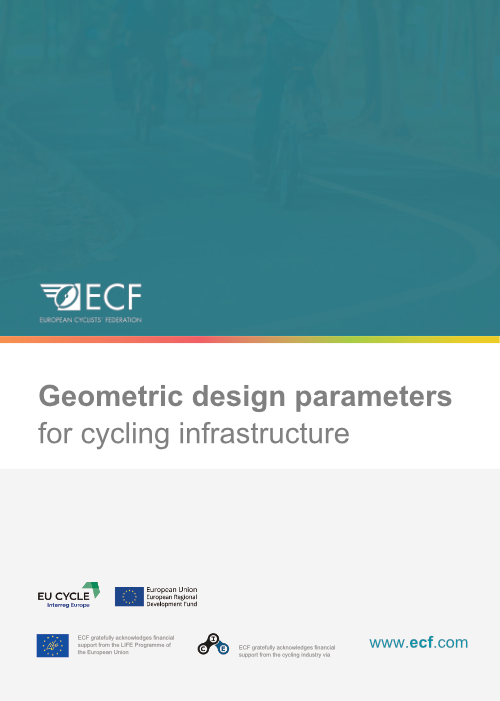 The geometry of cycling infrastructure is a critical aspect of its safety and comfort. In this factsheet we look at the geometric design standards for cycling infrastructure adopted across 15 different European countries.
The geometry of cycling infrastructure is a critical aspect of its safety and comfort. In this factsheet we look at the geometric design standards for cycling infrastructure adopted across 15 different European countries.
The focus of the factsheet is on the most common requirements in already existing national and regional regulations and guidelines. It should however be noted that there are also more in-depth, non-normative analytical models which consider more parameters.
 The proposal for a revised Trans-European Transport Network (TEN-T) regulation by the European Commission, published on 14 December 2021 as part of the “Efficient and Green Mobility” package, represents a step forward for cycling in urban areas, but also some missed opportunities.
The proposal for a revised Trans-European Transport Network (TEN-T) regulation by the European Commission, published on 14 December 2021 as part of the “Efficient and Green Mobility” package, represents a step forward for cycling in urban areas, but also some missed opportunities.
The European Cyclists’ Federation (ECF) welcomes the definition of “active modes” and the requirement for urban nodes to adopt Sustainable Urban Mobility Plans. However, while big cities are important, they represent only 30% of the EU population. There is a huge potential for cycling in smaller towns (in connection with trains for longer trips), and 42% of all cycling fatalities happen completely outside urban areas.
ECF has prepared a detailed set of amendments which we believe will dramatically benefit cycling across the continent. Download here.
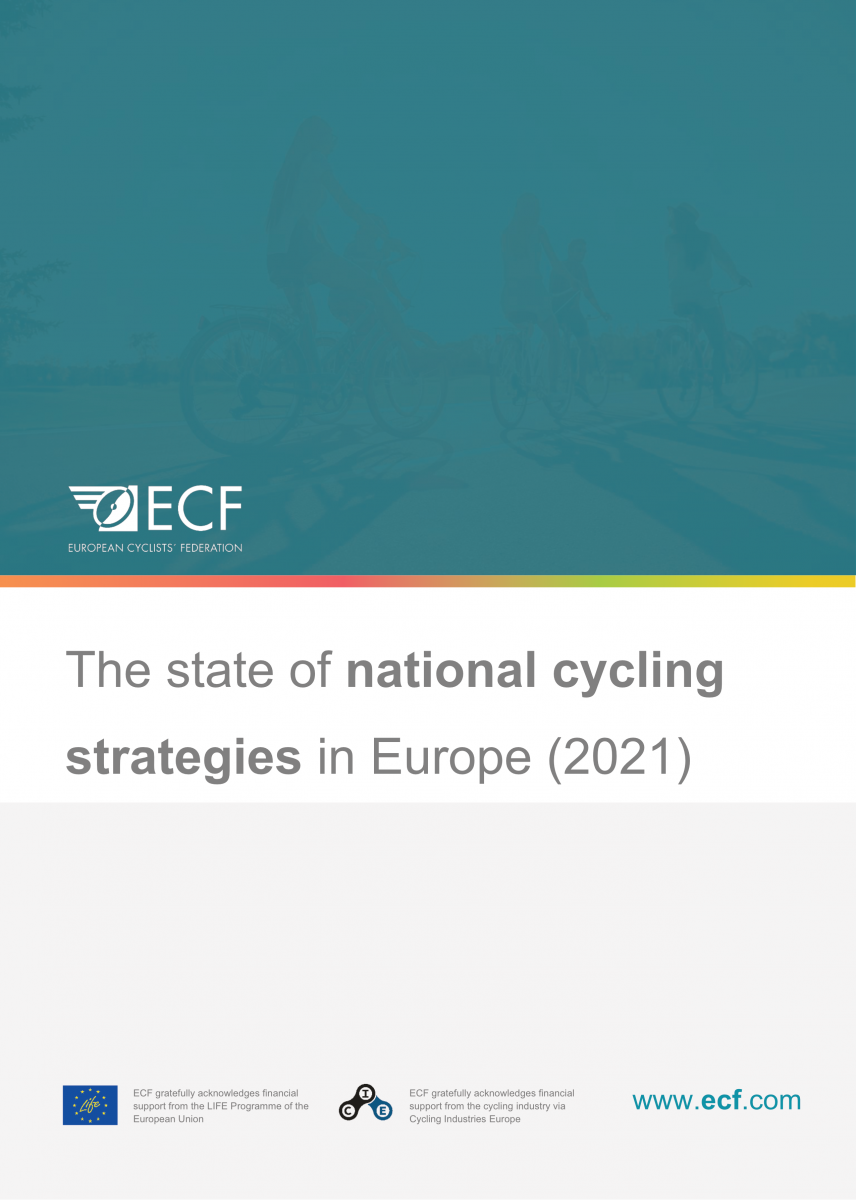 ECF has released a new report, "The state of national cycling strategies in Europe (2021)," which provides an overview of national cycling strategies in 47 European countries as of December 2021.
ECF has released a new report, "The state of national cycling strategies in Europe (2021)," which provides an overview of national cycling strategies in 47 European countries as of December 2021.
Executive summary
This report provides a comprehensive overview, for the first time ever, of the status of national cycling strategies in 47 European countries, at a time of growing political interest across the world in cycling as a sustainable and healthy mode of transport.
A national cycling strategy is a crucial policy tool for countries to develop and grow cycling’s modal share at the national level, with all the positive impacts that this generates, such as cleaner air, healthier and happier citizens, more liveable cities and towns, better rural connectivity and more vibrant local economies. National cycling strategies are also instrumental if the world is to cut transport emissions quickly and effectively and avoid the worst of the climate crisis.
With the adoption of the Pan-European Master Plan for Cycling Promotion in May 2021, under the umbrella of WHO/Europe and the UN Economic Commission for Europe, 54 countries in the pan-European region are now politically bound to develop and implement a national cycling strategy by 2030. But with data from 47 European countries, ECF’s analysis shows that most countries have a long way to go if they are to reach this objective.
Developing a national cycling strategy is not a new policy instrument. The Netherlands “invented” it in 1990, followed by Germany in 2002 and the Czech Republic in 2004. Yet half of the European countries have never implemented a cycling strategy or similar policy document (24).
Of 47 countries, 23 have at some point adopted a national cycling strategy. Cycling strategies are currently in force in only 13 of these countries, while they have expired and therefore need updating in ten, including in the cycling nation of Denmark. Of the remaining 24 countries analysed in the report, only five are currently in the process of developing such a strategy for the first time.
To reach the master plan’s 2030 goal, cut transport emissions and reap the many societal benefits of cycling, many countries must urgently begin the process of developing or renewing their national cycling strategy. Most of the countries that have never had such a strategy – and are not currently in the process of developing one – are located in the Balkans, Eastern Europe and the Caucasus.
While national cycling strategies can be instrumental for the development of cycling in a country, the scope and duration of such strategies differ widely. Some of the most popular measures pursued by countries include the promotion of intermodality (18), legal changes to highway codes (15) and the development of a national cycle route network (13). The duration of most strategies corresponds to the term of the government that adopted it (8), while others are seven-year (3), ten-year (6) or even 25-year strategies (Northern Ireland).
The findings in this report will provide a benchmark against which ECF intends to publish annual update reports to track progress on the development, implementation and effectiveness of national cycling strategies in Europe towards 2030.
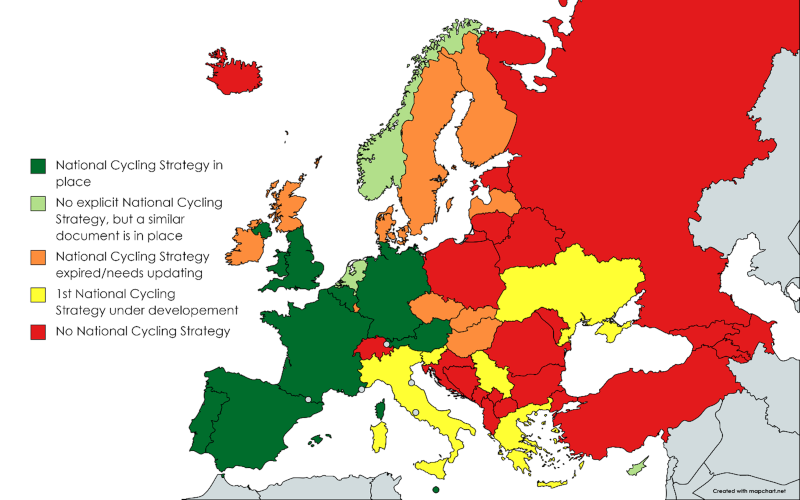
The vision we share with our members is to improve and increase cycling across the whole of Europe.
Read our 2030 Strategy summary.
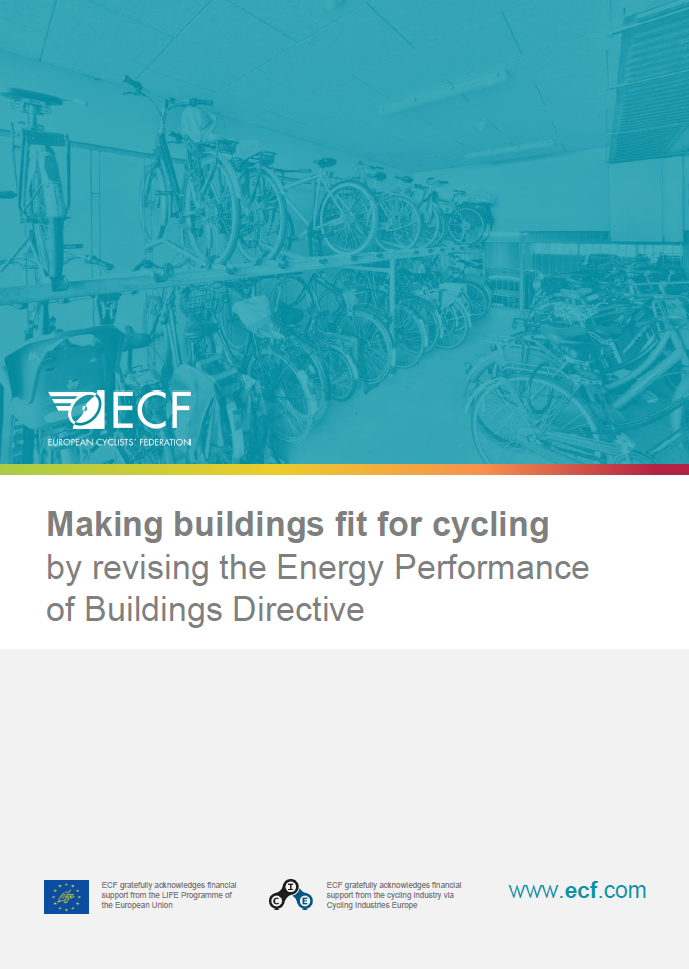 Executive summary
Executive summary
The European Cyclists’ Federation (ECF) welcomes the revision of the Energy Performance of Buildings Directive (EPBD) (EU) 2018/844 as part of the “Renovation Wave” strategy and the “Fit for 55” legislative package.
The last EPBD revision in 2018 established the link between the building and mobility sector by providing requirements for charging infrastructure for electric vehicles. ECF strongly supports this link as mobility related design and equipment in buildings impact modal choice and hence energy consumption, yet we regret that this directive effectively applies to electric cars only.
Beyond charging infrastructure, parking is a major determinant of an individual’s mobility choices; this is true for bicycles, cars and other personal transport modes. Put simply, if there is easy and convenient parking available at the beginning and end of a person’s journey for a specific mode of transport, this person is far more likely to choose that transport mode over another one on a regular basis.
The bicycle earns its place in the revision of this directive for at least three reasons.
- The bicycle is the most energy-efficient transport mode. An electric bicycle consumes at least five times less energy (per passenger-km) than an electric car (see Annex 1).
- A bicycle is also more space efficient than a car. Off-street bicycle parking as total space consumption per unit (ie the parking spot + access lanes) is up to 20 times lower compared to car parking. Providing more bike parking at the expense of car parking would help to keep increasing construction costs under control. The European Green Deal needs to go hand in hand with social balance.
- Consequently, bicycle parking per unit has a much lower carbon footprint compared to car parking. Less material resources are needed which has a positive impact on the overall life-cycle energy consumption of such buildings.
ECF therefore recommends to legislate these provisions in the forthcoming EPBD revision.
- To introduce minimum requirements for bicycle parking.
- To introduce minimum requirements for electric-bicycle charging infrastructure.
- To improve the social, environmental and mobility performance of buildings by better regulating requirements for car parking.
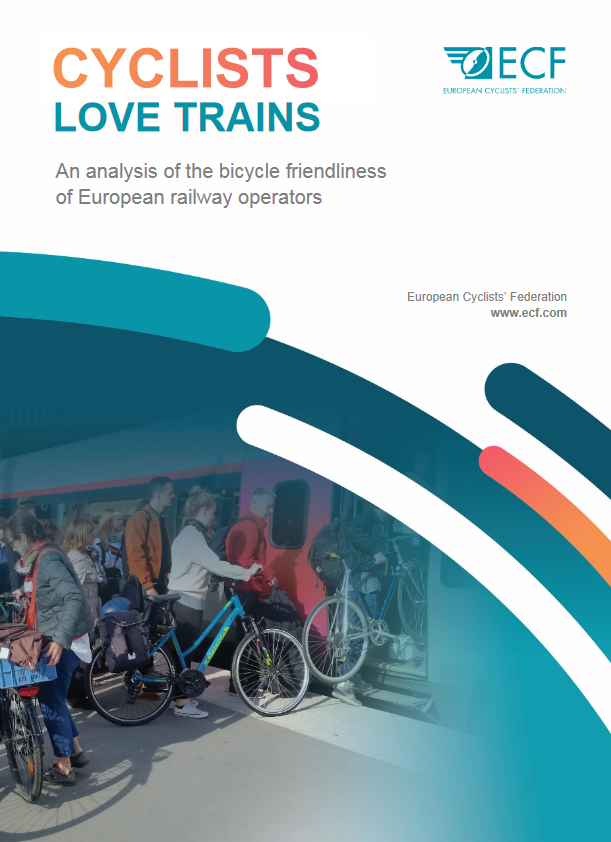 ECF has released a new report, “Cyclists love trains: An analysis of the bicycle friendliness of European railway operators,” which aims to guide industry and policymakers in identifying ways to improve the combination of two of the most sustainable modes of transport: bikes and trains.
ECF has released a new report, “Cyclists love trains: An analysis of the bicycle friendliness of European railway operators,” which aims to guide industry and policymakers in identifying ways to improve the combination of two of the most sustainable modes of transport: bikes and trains.
This timely new report analyses and ranks 69 European train companies and services according to six key indicators for combined bike-and-train travel, such as bicycle spaces in trains and the quality of bike ticket or reservation channels.
Erratum – the report’s ranking has been revised and updated for: TransPennine Express, VR Group, Westbahn. (19 July 2021)
Executive summary
At the European Cyclists’ Federation (ECF), the world’s largest and best-known cyclists’ advocacy organisation, we know that cyclists all over Europe increasingly want to be able to take their bicycles with them on trains.
ECF’s 2020 Cyclists Love Trains campaign, which aimed at influencing the EU Rail Passengers’ Rights and Obligations regulation in favour of provisions for bicycle carriage on trains, had tremendous popular appeal. No doubt such strong public support for combined bicycle-train mobility helped achieve the requirement for new and refurbished rolling stock to include a minimum of four dedicated bicycle spaces per train.
The European Commission has announced 2021 to be the European Year of Rail, an initiative that seeks to promote rail as one of the most sustainable, innovative and safe transport modes.
With this “Cyclists love trains” report, ECF in turn seeks to shine a light on the bicycle friendliness of train operators across Europe today. This extensive piece of research can be used by policymakers and industry leaders alike to benchmark their performance, study examples of shortcomings and best practices, and understand where there is clear potential for continued improvement.
Following extensive research, data processing and analysis, ECF has produced a ranking of 69 railway companies and services from across the European Union (EU) and beyond. Of these 69 undertakings, 15 of them – fully 22% – do not currently accept non-foldable and un-dismantled bicycles. 12 of these 15 railway companies are long-distance, cross-border and high-speed operators. This reality shows that taking a bicycle across Europe on a long-distance journey is often not a convenient or enjoyable experience, but rather an arduous one punctuated by many connections on slow regional and local services.
In 2021, against the backdrop of the European Green Deal, the climate crisis, and the COVID-19 recovery, this is not acceptable. It should be much easier for people to combine two of the most sustainable forms of mobility, not to mention to choose green alternatives to driving cars or taking aeroplanes.
There is some hope, however. The NS-DB joint venture, Intercity Berlin1 (IC Berlin), has topped this report’s scoring. It is the only undertaking to have scored in the excellent category, an achievement which was in part helped by the number of bicycles which can be carried on their train sets and the possibility to connect to both NS and DB’s bicycle hire schemes. The report’s runners up, Swiss Federal Railways (SBB), the National Railway Company of Belgium (SNCB/NMBS), Deutsche Bahn (DB) and Hungarian State Railways (MÁV-START) also scored well across the board. Yet, there is much room for further improvement across Europe.
The core premise underlying this report is “flexibility for the user.” NS-DB (IC Berlin) and other top-ranking undertakings have scored well because their bicycle carriage policies and physical infrastructure allow for more flexibility for the user than most of their peers.
However, companies which are doing well now are not predestined to do so in the future, and, as such, every company which is highlighted in this report should bear in mind the following things when it comes to offering good quality conditions for bicycle carriage:
- Acceptance of non-foldable and un-dismantled bicycles on all train services.
- A commitment to go above and beyond the recently mandated (recast EU Rail Passengers’ Rights and Obligations legislation) four dedicated bicycle spaces per train.
- Dedicated bicycle spaces which are accessible and easy to use for all types of passengers. Outside the scope of this report, but also very important, are the accessibility of platforms for passengers with bicycles.
- A commitment to investigate, and potentially invest in bicycle sharing schemes. Cost-effective bicycle tickets and reservations that can be acquired via multiple different booking and sales channels.
- The provision of clear and concise information on bicycle services, which is available in more than one language and provides information about the carriage of non-standard bicycles.
- A website that offers a bicycle connection search tool in its journey planner.
- A pan-European journey planner and coordination of bicycle carriage rules in the face of the marketisation of European railways.
- Commitment to providing flexible reservation periods, which provide the maximum flexibility and ease of use for passengers.
- Ample, covered bicycle parking at stations, with provisions for non-standard bicycles, in addition to the provision of e-bike charging points.
Cyclists love trains, but their love is not unconditional. We at ECF urge European, national and regional governments and rail operators to take these recommendations on board. If they do, combining bikes and trains will be a more viable option, and a much more pleasant experience, for many more cyclists in Europe.
The year 2020 was influenced in every way by the global pandemic. As tragic and challenging as it has been, it has also had a silver lining for cycling, with cycle use soaring in most European countries.
Read ECF’s Annual Report 2020.
The ECF welcomes the opportunity to contribute to the current review of the Trans-European Transport Network (TEN-T) guidelines.
A significant increase in the number of trips made by bike is crucial for achieving the goals and targets of the European Commission. It will be needed to help meet the objectives of the European Green Deal and contribute to reducing the transport sector’s greenhouse gas emissions by 90% by 2050. Cycling must therefore play a central role in Europe’s transportation network and, by extension, TEN-T – the EU’s flagship transport policy.
The ECF proposes two measures to ensure cycling is better integrated into TEN-T:
- Integrate EuroVelo, the European cycle route network, into TEN-T. EuroVelo should be included as a fully-fledged TEN-T network alongside the networks for other modes. As the European cycle route network is already well-established, its integration into TEN-T would be easy to achieve and entail tremendous benefits for the whole policy.
- Integrate cycling infrastructure into all TEN-T infrastructure projects. The potential for cycling traffic in the area covered by the respective projects should be evaluated and necessary elements of cycling infrastructure should be integrated into project planning, design, and construction. This should include the following measures:
- cycle routes along TEN-T corridors;
- safe and comfortable cycle crossings across TEN-T corridors;
- upgrading other roads affected by TEN-T projects to safe cycling standards;
- cycling connections in TEN-T urban nodes.
The review of the TEN-T guidelines represents an opportunity to level the playing field for transport modes.
The update can correct the limitations of the current approach and foster an unprecedented growth in cycling infrastructure across the EU.
In the European Green Deal, released late 2019, the Commission announced its decarbonization objective: no net emissions of greenhouse gases by 2050. To achieve this objective, transport emissions must be reduced by 90% by 2050 compared to 1990. Because the National Energy and Climate Plans (NECPs) are among the EU’s primary methods to meet its climate goals, these plans must include bold transport decarbonization measures. There is no conceivable way for the EU to achieve decarbonization without a major, further shift towards more cycling. In fact, a Global High Shift scenario with an emphasis on cycling and e-cycling could cut CO2 emissions from urban transport by nearly 7% by 2030. To achieve zero-carbon emissions across Europe by 2050, it is therefore vital that European countries strongly support and fund cycling.
To determine the role of cycling, we assessed the 27 draft and final NECPs 2021 – 2030. We found that the attention given to cycling has improved since the (2018) draft NECPs: from a draft score of 2.7/10, the final NECPs scored 4.35/10. However, many Member States still did not add enough measures to support or fund cycling. This moderate score shows that Member States have begun to take the decarbonization potential of cycling seriously, but there is still a long way to go. Cycling must be considered a necessary tool to decarbonize road transport.
How can we help families to cycle more often? Why do some cylists prefer cycle paths and others cycle lanes? What are the road safety implications of electric cycling? You can find answers from both researchers and practitioners to these and many more questions in the new publication "Framing the Third Cycling Century", edited by the German Environment Agency and the European Cyclists' Federation.

